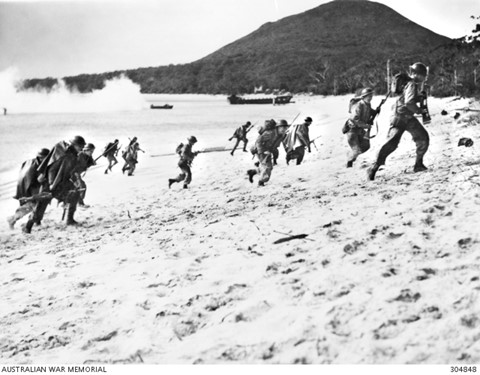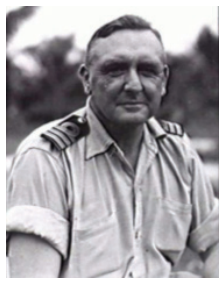Starting in 1942, around 1000 Australian sailors were trained in amphibious warfare. In May-July 1945, they participated in the liberation of Borneo, primarily by providing landing craft crews, beach parties and signals teams for amphibious landings at Tarakan, Brunei Bay and Balikpapan.
The World War II naval beach commandos hold a unique place in Australian naval history. From 1942 to 1945, around 1000 Royal Australian Navy (RAN) sailors trained in amphibious warfare alongside their compatriots from the army and air force, and large numbers of United States (U.S.) servicemen. These sailors played an instrumental role in the Operation OBOE landings in Borneo at Tarakan, Brunei Bay and Balikpapan in 1945.
Training
In March 1942, the Australian government recognised the importance of an amphibious capability in any effort to drive the Japanese out of the Pacific. It began exploring the requirements for combined operations training in Australia. Two training centres were established before the end of the year: the Combined Training Centre at Toorbul Point (now Sandstone Point), on Moreton Bay, Queensland; and the Joint Overseas Operational Training School at Port Stephens3, north of Newcastle, New South Wales.
With construction work progressing ashore at Port Stephens, HMAS Assault was initially commissioned aboard the armed merchant cruiser HMAS Westralia and began providing instruction for landing craft crews, beach parties (naval commandos) and combined operations signals teams. Assault transferred ashore on 10 December 1942. An American Amphibious Training Group was established nearby and the two facilities were combined as the Amphibious Training Centre in February 1943 under the overall command of the commander of the U.S. 7th Amphibious Force, Rear Admiral Daniel E. Barbey USN.
HMA Ships Kanimbla, Westralia and Manoora also were converted into infantry landing ships (LSIs) during 1943.

Training at HMAS Assault was intense, covering every aspect of landing operations on hostile shores. Sailors had to partake in assault courses, instruction in various weapons and explosives as well as hand-to-hand combat. Former naval commando, Able Seaman Ted Jones, recalled training with his unarmed combat instructor, Lieutenant Donald Davidson: “Over and over again he would impress upon us that we were being trained to fill a commando role and in such a role we could quite easily find ourselves in a position where we had to depend on our hands, eyes and senses to prevent an enemy in hand-to hand combat from killing us … it was – kill or be killed – and this was reality, not supposition” (Jones 1998).
The commandos also had to learn how to conduct inwater beach surveys which would often leave them immersed fully clothed for hours on end, as well as constructing makeshift metal ‘roadways’ on the beach enabling the landing of vehicles as large as a tank.
Having trained some 20,000 U.S. soldiers and marines, 2000 Australian soldiers and 1000 sailors, the Amphibious Training Centre closed in October 1943, although HMAS Assault continued operating on a reduced basis. Thereafter, all amphibious training facilities were based at Toorbul, which became the centre for amphibious activities in the Southwest Pacific Area (SWPA). Most of the RAN’s 120 naval commandos as well as Kanimbla, Westralia and Manoora, were transferred to Toorbul. In addition, shortly after training at Port Stephens ceased, a detachment of naval commandos proceeded to Cairns for training with the army’s Australian Beach Group.

their skills in action, they had to endure a long wait while U.S. formations took priority during subsequent amphibious assaults across northern New Guinea and the Philippines.
Operations
Tarakan – May 1945
The RAN naval commandos first saw action on 1 May 1945 during Operation OBOE I, the assault on Tarakan Island off Borneo. Tarakan has an area of only 135km, and largely consists of mangrove swamps with a hilly, forested centre. The port of Lingkas was selected for the landing as it had the Island’s best beach, though hardly ideal being 2km long by 90m wide and composed mainly of soft mud up to three metres deep. Westralia and Manoora formed part of the RAN contingent at Tarakan.
The LSIs carried Naval Beach Commando B, comprising 14 officers and 107 ratings under the command of Lieutenant Commander Bernard Morris RANVR, five observers from Beach Commando D, as well as units of the 9th Australian Division. Six telegraphists from Naval Beach Signal Section D were also loaned to USS Rocky Mount and later landed on Tarakan to replace casualties.
The main invasion force entered Lingkas before dawn on 1 May. A shore bombardment swept the area before the landing craft thrust up onto the beach giving the commandos a dry landing. Throughout the course of the day and into the night, hundreds of tonnes of equipment and personnel were disembarked from Westralia and Manoora and the LSIs departed at around noon the following day.
The beach commandos landed with the first wave of each forward battalion. They carried out reconnaissance, marked beaches, established and maintained signal communications, organised and furthered the unloading of landing craft, salvaged craft that became stranded, and generally organised and conducted all the work on the beaches (Gill 1968). This was no easy task as the jetties were damaged and the tide had receded. All of the RAN’s casualties during this operation were beach commandos – telegraphists John Brady and William Ryan were killed and a signalman wounded when a Beach Control Point came under shellfire on 2 May. Lieutenant Commander Morris continued to act as Port Director until relieved on 17 May.
Brunei Bay – June 1945
All three Australian LSIs took part in the amphibious phase of Operation OBOE VI, the assault on Brunei Bay on 10 June 1945. Beach Commando A, under the command of Lieutenant Commander Ron McKauge DSC RANVR, was embarked on this occasion, once again in company with units of the 9th Australian Division. This time the naval commandos, numbering 20 officers and 157 ratings, were divided into three beach parties. The main body of the assault group landed on Labuan Island, dubbed Brown Beach, while a smaller force, from Kanimbla, landed at Muara Island and Brunei Bluff – White and Green Beaches respectively – which were some 32km from the main assault. The selected beaches in Brunei were wide and sandy, much better suited to amphibious landings than those at Tarakan. The assault group entered Brunei Bay before dawn and, in spite of the shore bombardment, landing craft came under sporadic sniper fire as they approached the shore. The snipers, however, only succeeded in revealing their positions and were soon stopped by Allied guns. The beach commandos were first ashore at 0915 hours and little more than an hour later all three beaches were secured without casualties. The commandos again played a leading role during the assault as well as in organising the follow-on Allied forces. General Douglas MacArthur expressed his satisfaction to the commandos, remarking: “The execution of the Brunei Bay operations has been flawless … convey to your officers and men the pride and gratification I feel in such a splendid performance” (Jones 1998).
When the amphibious fleet departed, the beach commandos stayed behind, employed in various duties including patrol and survey. They were withdrawn on 27 June through the Australian Beach Group Camp on Labuan Island.
Balikpapan – July 1945
The beach commandos’ final action in World War II was during Operation OBOE II, the 7th Australian Division’s amphibious assault at Balikpapan. In addition to the army contingent, the three LSIs embarked 17 officers and 150 ratings of Beach Commandos B and D, under the command of the experienced Lieutenant Commander Morris Klandasan. The southern end of Balikpapan Bay was identified as the best landing site despite the relative shallowness of the water and the strength of enemy defences. Some 25km of coast was protected by a log barricade and around 3500 Japanese and 6500 local conscripts covered the beaches with automatic weapons. Heavier installations farther inland provided defence-in depth. The Australian landing force also had to contend with an extensive shallow-water minefield, laid originally by the Allies, which took 16 days to make safe. Three beaches, designated Red, Yellow and Green, were selected for the landing.
The Balikpapan assault group arrived before dawn on 1 July and the beach parties started transferring to the landing craft at 0710 hours. The shore bombardment began 10 minutes earlier and, apart from a well protected 3-inch gun which did little but force the troops to take cover, effectively destroyed the larger shore defences. The beach commandos, as always, were first ashore at 0855 hours and although they suffered no casualties during the landing, some of their mates in the 7th Division were not so lucky.
The commandos in the first wave directed naval gunfire and, by the time the third assault wave landed at 0903 hours, the Japanese mortars and pillboxes had been destroyed. During the day, the beach parties directed the landing of 10,500 troops, 700 vehicles and 1950 tons (1980 tonnes) of stores over difficult beaches with more than a metre of surf running (Gill 1968).
Conclusion
The assault at Balikpapan was the last amphibious landing of the war. The Naval Beach Commando Units were disbanded shortly afterwards. Their men were reassigned throughout the RAN, many remaining in the SWPA and some returning to Australia.
They had gone about their job with a minimum of fuss and a great deal of pride, and though their important role is sometimes overlooked, their exemplary performance was recognised by Rear Admiral Barbey, who reportedly “chided his American commanding officers … for persistently being outperformed by those Goddamn ‘Ossies’ in our speed of over-beach unloading, consistent timing and very low landing craft damage”. This was high praise indeed for some of the RAN’s most unusual sailors.
References
Gilfillan, Colonel Kim (2019). Force from the sea: Australia’s amphibious capability – an update. United Service 70 (4), 12 – 17.
Gill, G. Hermon (1968). Australia in the War of 1939-1945, Series Two, Navy, Volume II, Royal Australian Navy 1942-1945 (Australian War Memorial: Canberra).
Jones, A. E. (1998). Sailor and commando: a Royal Australian Navy Special Service beach commando, 1942-1946 (Hesperian Press: Carlisle, Western Australia).
Weatherall, Dennis J. (2020). HMAS Assault: WWII Combined Operations Directorate Establishment – Port Stephens NSW. Naval Historical Society of Australia Occasional Paper No. 77.
Written for RUSINSW by Petar Djokovic – Senior Naval Historical Officer, Sea Power Centre – Australia
Contact Royal United Services Institute about this article.






